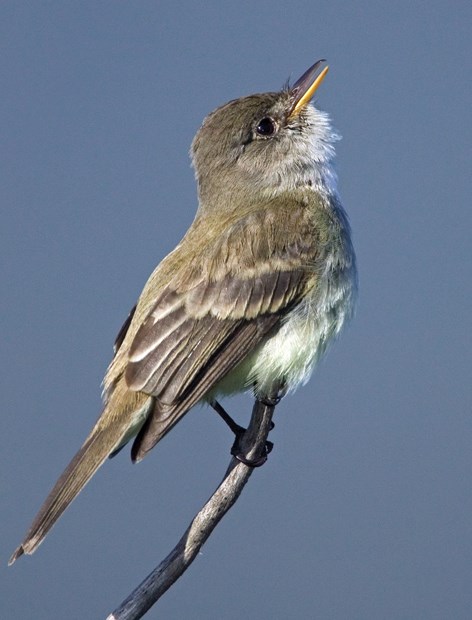You are watching a bird perched on a nearby tree branch when suddenly it darts out to nab an insect in mid-air.
Flycatching, also known as hawking, is a feeding behaviour of many birds, including waxwings, blackbirds and flycatchers.
The flycatcher family is large with more than 400 species - 24 on the B.C. list (Biodiversity Centre for Wildlife Studies, 2007), and 11 on the list for The Conservation Area at Maplewood Flats (2014). On the North Shore there are emphids, such as the willow, Pacific-slope, and Hammond's flycatcher, as well as the olive-sided and its cousin, the western woodpewee.
On a visit to the conservation area watch for the Pacific-slope and willow in woody habitats, and the pewee in wetter habits like ponds.
Empids (from Empidonax, the genus to which these birds belong), can challenge identification skills of even the most seasoned birder. The good news is that they all have distinctive voices and field marks that are subtle, yet distinct. The willow flycatcher commonly heard around the sanctuary says, "fitz-bew." It really does sound like that! And, the olive-sided flycatcher proclaims itself with a hearty, "quick three beers!" Recently, at Maplewood, there have been some rare, and very exciting, flycatcher sightings: dusky (very rare); and two kingbird species, western and eastern.
On one occasion, "east met west" as they sat side by side. The eastern kingbird is seen in small numbers around the Lower Mainland, but the western kingbird, a species associated with the dry Interior, is rare locally. To see them perched together was a wonderful sight.
As noted, flycatching, or hawking, is a habit practised by many birds. When carpenter ants take to the air in summer, robins and sapsuckers snatch them from the air with great skill.
The cedar waxwing is usually associated with eating fruits, like wild cherries, but it is an excellent hawker, sometimes taking dragonflies. And who would associate flycatching with hummingbirds, but flycatching they do. With their remarkable eyesight they can spot tiny flies from a distance and then dart out to catch them with amazing accuracy.
Red-winged blackbirds are associated with ponds and other wetlands. It is quite wonderful to watch them snatch dragonflies from mid-air.
The song sparrow is commonly seen around pond edges gleaning insects from the vegetation, but when there's a hatch of mayflies or damselflies, it swings into action by hawking them with superb skill - something very exciting to watch.
I recall watching a great blue heron as it stood motionless in the cattails. As dragonflies cruised by, it would snatch them from mid-air - no misses either.
Swooping is another insect feeding method used by birds like swallows, swifts and nighthawks.
In this way insects are caught on the wing. For example, purple martins at the conservation area have been observed catching dragonflies like the large darners.
Stephen Kress, author of Bird Life, A Golden Guide, notes, "These birds do not fly about with their mouth wide open. They locate prey by sight - then swoop in and open their beak just in time to snap up the flying insect. Most birds that feed this way have modified rictal bristles that look like eyelashes rather than feathers." The merlin, a small falcon, has also been seen catching dragonflies in mid-air at Maplewood - again a fine example of keen eyesight.
A good time to watch for swifts (and swallows too) is when a weather system moves in. Two species occur on the North Shore: Vaux's and black. Swifts are sometimes confused with swallows but their wings are longer and more curved.
Vaux's swift is the western counterpart of the chimney swift, with similar habits. Black swifts nest near waterfalls, while the Vaux's swift nests in hollow (wildlife) trees.
Did you know that bird's nest soup is made from nests of Asiatic swifts and that the European swift does much of its sleeping on the wing?
The more we learn about the lives of birds, the more amazing it becomes - a world of wonder and of beauty. And what better place to enjoy birds and other wildlife than the North Shore's Conservation Area at Maplewood Flats.
Keep safe.
Al Grass is a naturalist with Wild Bird Trust of British Columbia, which offers free walks at The Conservation Area at Maplewood Flats on the second Saturday of every month. The next walk will be Saturday, July 11 starting at 10 a.m. Participants will be looking and listening for summer birds, like flycatchers, swifts and swallows. Meet at WBT's site office, 2645 Dollarton Hwy, North Vancouver. Walks go rain or shine. wildbirdtrust.org



